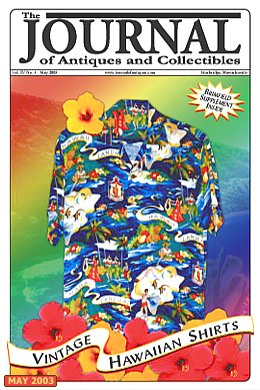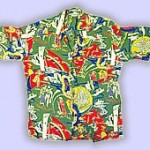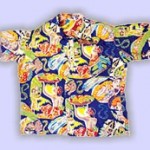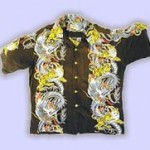Designs from the Golden Age of Hawaiian Shirts – The Journal of Antiques and Collectibles – May 2003
by Gary L. Moss
Lasting a mere two decades and beginning more than a half century ago, the “golden age” of Hawaiian shirts has left an enduring fashion legacy. Once you have worn a World War II-era vintage “silky” rayon “Hawaiian” or “aloha “shirt,” you begin to understand what attracts so many zealous collectors who are sometimes willing to pay what seems like incredulous sums of money for what many people refer to as “just a shirt.” It is these very qualities, however, that has helped the Hawaiian shirt mystique retain its popularity. Some of the words used to describe the experience of wearing a vintage rayon Hawaiian include “liberating,” “exhilarating,” “energizing,” “fun,” “cool” and “neat.” In addition to the immense enjoyment that one receives from owning and wearing these shirts is the knowledge that they have proven to be a worthwhile investment, not only financially but to help preserve what has become part of our American heritage.
Today the shirts that command the highest prices and demand from collectors and dealers are those made during what is considered the “golden age” of the “aloha shirt,” which was from the early 1930s to the early 1950s. During the first few years of their popularity, aloha shirts were made and sold exclusively in small, privately-owned tailor shops. The growth in tourism to Hawaii fueled demand for unique items that visitors to the island could return home with to remind them of their time spent on the island. Colorful, comfortable, and affordable apparel fit the bill.
Tapa cloth, hand made and colored from the inner bark of the Wauke tree, and used for years as the source of clothing throughout Polynesia, inspired many of the beautiful colors and patterns used by the “golden age” shirt designers. One of the first modern-style shirts was a three-button pullover made from a kabe crepe material often with an oriental motif. Another early 1930s style used an oriental motif made from Japanese silk kimono material with a long, wide, pointed collar. One rule of thumb used to date Hawaiian shirts is the longer and wider the collar, the older the shirt.
Many textile historians hold different of opinions as to who was the “true” originator of the modern-style aloha shirt. Some believe it was Ellery Chun, who while working for his family business, King-Smith, received the first trademark for aloha sportswear on July 15, 1936. Others support Koichira Miyamoto, known as Musa-Shiya the Shirtmaker, who advertised the “aloha shirt” in the Honolulu Advertiser on June 28, 1935, as the one who made the first custom-made aloha shirts, which sold for 95 cents. In any event, during the Depression, increased immigration of Japanese textile merchants and Hawaii’s access to Japanese silk merchants made the material for sportswear shirts convenient, affordable, appealing, and accessible.
The graphic images that many designers used were inspired by Hawaiian culture, such as the “Aloha Queen,” who is shown holding torch ginger while wearing a formal gown with a long, flowing train known as a holuku. The feather cape worn by warriors on their shoulders is also graphically depicted and the mahiole helmet is the central element in this rare design. Flowers, trees, and plants native to Hawaii were also popular subjects. The island’s best known recreational activity, surfing, is depicted in Deco style in this late 1930s shirt .
Border shirts are less common but are quite popular today. The design of these shirts typically follows the vertical borders of the shirt, which often required the maker to use more fabric due to the intricacy of the design. The pocket fabric was cut and placed in a manner that would not disrupt the overall pattern. A feather kahili , a potpurri of undersea life, and an island maiden are all woven into the border print design.
Coveted early aloha shirts from manufacturers such as Kamehameha, Kahala, Watumalls, Malihini, Kuu-Ipo, Poi Pounder Togs, Surfriders Sportswear, and dozens of others can now command in excess of $1,000. The Kamehameha Garment Company, taking its name from Hawaii’s legendary King Kamehameha I, who united all the islands in 1795, was one of the first companies to make and distribute ready-to-wear aloha shirts in 1936.
But one of the fascinating, yet unexplained, phenomena about Hawaiian shirts is the vast range of appeal that a particular shirt pattern and color can evoke from different collectors. In many instances, the visual appeal of these shirts is similar to the experience one receives when viewing a painting or work of art. And because “beauty is in the eye of the beholder,” any one particular pattern can be prized by some and disliked by others.
Interestingly, the same shirt can have a value range of several hundred dollars. Color, design, condition, maker, and size are the primary factors that affect value. A shirt that is small with a white background may sell for half ? or less ? of the identical shirt in a large size with a black, red, or dark blue background. Black backgrounds are often the most desired, while white backgrounds the least because they are the most common. The greater the number of colors used, the more desirable the shirt. Most shirts will typically have from three to five colors, but there are some that have seven or eight colors, enhancing the shirt’s visual appeal and value in today’s market. Other qualities to look for in better made vintage shirts are coconut buttons, double stitched seams, selvage or inside flap under the buttons and button holes, horizontal button holes, no stitching on the top of the collar (excluding a handful of the better makers), and a top button collar loop.
In the early 1950s, expansion of the cruise ship industry brought many more tourists to the islands. Highly sought after today are shirts designed by known artists who were commissioned to design fabric, murals, and menus used on the Matson and Lurline cruise ships, such as Eugene Savage designs and the stylized surfboard and lei designed by John “Keoni” Meigs. The start of United Air Lines service to the islands in 1951 was commemorated with a shirt showing Mr. McGuire, a local realtor, welcoming tourists to the island.
Shirts from the 1950s and 1960s by makers as Reyn Spooner, Paradise Island and Rai Nani have in the past few years become collectible, but do not command the high prices of the earlier shirts. Some late shirts show themes inspired by popular symbols of the late 1960s hippie period. Today, a limited number of select companies in Hawaii and Japan are currently offering new rayon shirts in the “golden age” patterns at a cost of upwards of $200 per shirt. Keep in mind one unbreakable rule should you decide to purchase and wear a rayon Hawaiian shirt: they are never tucked into your pants.
Dr. Gary L. Moss, OD, MBA is an associate professor at The New England College of Optometry in Boston and an adjunct faculty instructor at Emmanuel College in Boston and Regis College in Weston, MA. His book, [amazon_link id=”076431758X” target=”_blank” container=”” container_class=”” ]Hippie Artifacts[/amazon_link], was recently published by Schiffer Publishing. He also co-authored [amazon_link id=”0750672382″ target=”_blank” container=”” container_class=”” ]Eyecare Business: Marketing and Strategy[/amazon_link], published by Elsiver Health Science.
His vintage Hawaiian shirt collection, which includes 175 shirts from the 1930s to 1950s, will be on exhibit at the American Textile History Museum in Lowell, MA, from November 15, 2003 until March 2004. He lives with his wife, Traudi, and two teenage daughters, Amber and Blaise, on Renaissance Farm, an equestrian riding and training facility, in Westford, MA, and has never been to Hawaii.
[amazon_carousel widget_type=”SearchAndAdd” width=”550″ height=”200″ title=”More on Hawaiian Shirts” market_place=”US” shuffle_products=”False” show_border=”False” keywords=”Hawaiian Shirts” browse_node=”” search_index=”Books” /]








Related posts: